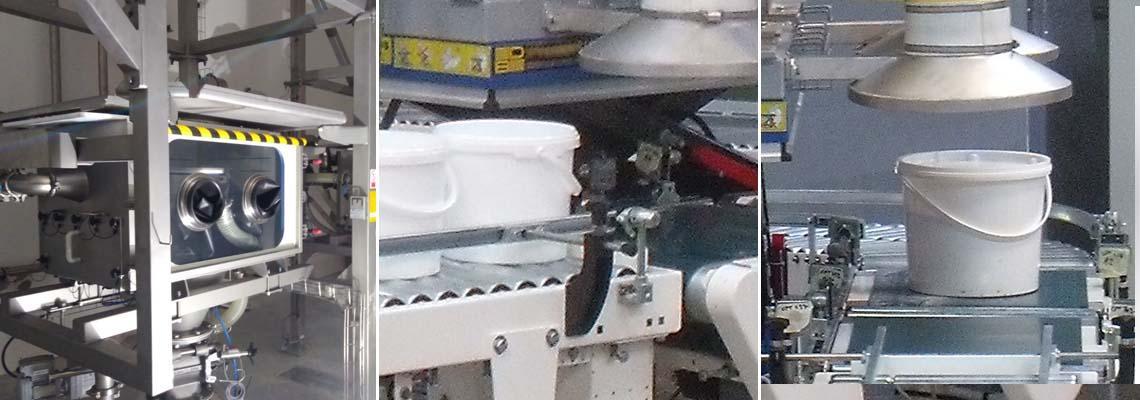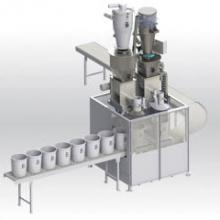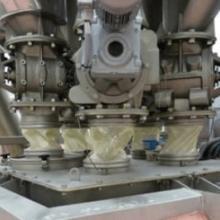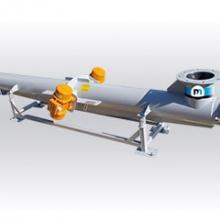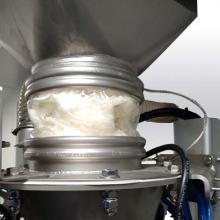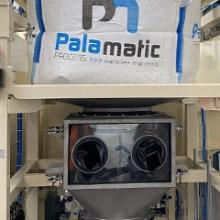Material: Graphite
Bucket filling line
Project Objective: Our client, located in South New Jersey, USA, is a manufacturer and supplier of bearings and polymer coatings. The production process required mixing graphite powder with resins for feeding into their extrusion process to create the bearing products. The current method involved manually scooping, pre-weighing and hand dosing graphite into buckets of resin. The buckets would then be manually mixed to create the correct formulation. Because of the extremely light density of graphite powder and its classification as a potential carcinogen, the client wanted to automated the dosing of this bulk material into the buckets while avoiding operator exposure.
Industrial Solution: Our powder handling experts put together a turnkey system solution that would eliminate any manual handling of the powder and pre-dose the graphite powder into the 20kg buckets. First step was to find a better delivery method of the raw material. Our client received graphite powder in 200kg drums. Through careful study, our team discovered the graphite powder could be delivered in big bags. By switching from a steel drum to a big bag, the delivery method was cheaper and simpler to incorporate into an automated system. A big bag would last several days to meet the production requirements of the client. The next steps were to design a solution to pre-weigh and accurately dose the material into a 20kg bucket utilizing a loss-in-weight vibrating feeder and fully contained bucket filling line.
1. Big bag Unloading Station with Glovebox – Easyflow® EF2
By switching the bulk container delivery method with the graphite supplier, our bulk material handling system could run for several days of production without the need for re-supplying the industrial line. Therefore, we start the installation with a big bag emptying station, Palamatic Process model Easyflow® EF2.
Because of the toxic nature of the graphite material, all potential exposure to operators must be eliminated in this industrial process. Our team integrated a glove box design into the unlacing cabinet, just below the big bag deposit tray.
By using gloves built into a window, an operator could reach through the glass and untie the big bag spout without risk of exposure. The FIBC could be loaded onto the station by using an electrical hoist rated for the maximum weight of the bulk container. For additional material containment, the big bag spout could be connected to a telescopic tube that would raise up to meet the height of the spout. A clamping mechanism would secure the bottom of the spout in a dust-tight connection.
The telescopic tube could then retract to stretch the big bag and cause a funneling effect, promoting good material flow. An access platform was integrated into the big bag unloading station for quick and easy access to the untie box for operators and maintenance needs. A gravity rotary valve would control the material flow from the big bag into the powder dosing unit below.
2. Loss-in-Weight (LIW) Vibrating Feeder
Fitted between the gravity rotary valve and the powder dosing equipment is a flexible fitting. These flexible connectors are used when trying to isolate the weight of the connected manufacturing equipment for increased weight dosing accuracy. The flexible fitting is then attached to the hopper inlet that feeds the vibrating conveyor.
The bulk material buffer hopper has a capacity of 10 kg of graphite, or the equivalent of preparing three buckets with the material. A high-level probe is also integrated into the buffer hopper to avoid over filling from the big bag supply. Vibrating dosing equipment is especially suitable for powders and granules that are friable or particularly abrasive. Because of the immediate flow reaction to the start and stop of the electro-magnetic drive, vibrating conveyors can offer greater dosing accuracy over their counterparts, like screw feeders.
Four load cells are installed under the support feet of the vibratory feeder to provide automated loss in weight function. As the material drains from the buffer hopper, the PLC can tell the powder feeder to turn on and off, with a degree of accuracy in the +/- 20-gram range. Furthermore, the industrial machine can be adjusted to increase / decrease accuracy or, increase / decrease flow rates. This is carried out by utilizing a slide gate at the bottom of the hopper where the powder corridor meets at the exit. By closing off the guillotine valve, the rate is decreased but the dosing accuracy is increased. Vice versa, by opening the powder flow control gate, the flow rate is increased but the accuracy is decreased.
3. Paldrum®03 Automatic Bucket Filling | Dust Enclosure Cabinet
In order to fully ensure that no dust could possibly escape into the surrounding atmosphere and risk operator exposure, the entire bucket filling assembly was inside a physical containment unit. Made of mild steel, the dust enclosure surrounds the filling head, roller conveyors and buckets being prepped with the graphite material. The enclosed powder filling line consists of:
- Inlet mechanical roller conveyor (for the supply of the empty buckets)
- Graphite filling station
- Glove box station – for sealing the buckets
- Inlet and Outlet roller doors – to fully contain the station and allow a quick feed or release of the buckets
- Outlet gravity roller conveyor
The operator prepares several empty buckets on the infeed conveyor line, and one by one the buckets are indexed into the fill station. The roller gate opens and allows one bucket at a time to enter, immediately closing as soon as the bucket passes into the inner chamber. An operator can make use of a foot pedal to easily call for the next bucket in line. Sensors also tell the PLC where to position the bucket in an automated way.
The bucket is then positioned under the filling head where a pneumatic cylinder lowers a telescopic tube with containment lid over the bucket. The filling head is connected to the outlet of the vibrating feeder via a flexible connection tube. The control panel then signals the powder feeder to dose the appropriate amount of graphite powder into the bucket. Once the correct amount is dosed, the bucket cap and telescopic tube retract.
A vibrating densification table raises between the rollers and shakes the bucket. The material is deaerated and densified. Once finished, it retracts back under the roller conveyor and the bucket is moved to the lid placement station. An operator reaches through a glove box where he can take a lid from the stock shelf inside the enclosure and place it securely on the bucket. Once the lid is secured, the outlet roller gate quickly opens and the bucket is transferred down a gravity conveyor for staging at the resin mixing station.
4. Industrial Dust Collection Unit
Another production goal of the client was to integrate an independent dust collection unit into the automated powder filling system. This served two primary purposes: 1. the entire assembly was connected to the dust filter to create further redundancies and safeguards against this dusty material and prevent operator exposure, and 2. reclaim any lost material from the powder filling device to realize potential material supply savings. The client could have easily tied this system into their existing central dust network. However, if they had done so the client would have not been able to reclaim any graphite material that was lost to the dust collector.
This is because the graphite would have mixed in with other polymer-based powders resulting in contamination of the graphite. The industrial bag house was made of mild steel with a fan flow rate of 1,000 m³/hr and air throttle adjustment valves to have more control over air flow rate. The filtering area of the cartridges is up to 47 m² and power requirements from 0.75 up to 11 kW. The filters are connected to a reverse pulse jet cleaner that sounds blasts of highly pressurized air to clean excessive dust build up from the filters. A 200 kg steel drum is connected via a manual butterfly valve to the outlet of the discharge hopper for material collection.
All equipment contact surfaces are made of 304 stainless steel and PLC communication is driven via an Allen Bradley ethernet connection.
Palamatic Process has been supplying the powder and bulk solids industry with big bag handling equipment since 1992. In order to determine what solution is best for your project, contact one of our sales engineers. Together, our team of experts can provide the right kind of powder filling equipment that will meet your production goals.
Contact one of our experts today for assistance with needed material handling solutions and to request a quote.














